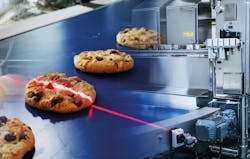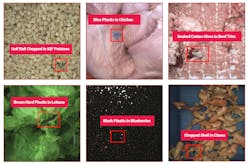AI vision for food quality and safety: What works and what doesn’t
It is remarkable how quickly artificial intelligence (AI) has changed from an intriguing idea into a hot topic in our society — and it is only the beginning. The food industry is a key driver of AI innovations for manufacturing and processing. Major food brands invest heavily and have deployed several diverse AI applications in recent years targeting improvements in food safety, quality and product throughput.
As new AI applications emerge, companies are under pressure to embrace them quickly. In the case of AI-powered vision inspection technologies, some companies have had a fast return on investment. Nevertheless, without a practical understanding of how AI works, and the effort required to make an application successful, companies can quickly enter down a frustrating path.
Accelerated production throughput drives necessary quality control changes
Quality control and processing inspection systems are among the fastest-growing AI technology categories in food manufacturing. From portioned meat products to baked goods, today’s factories are being pushed to their operational limits to achieve greater product throughput while maintaining the quality standards their customers expect.
Errors are byproducts of accelerating production speeds without improved quality control processes. Many food companies still depend on human inspectors to catch underbaked cookies or chicken tenders missing their breading by watching the processing line, but with fast production speeds, expanding facilities and difficulty finding labor, it is nearly impossible for them to make accurate and consistent quality decisions using traditional methods.
Growing demands to detect potentially harmful foreign materials from the processing line complicate matters further for today’s food manufacturers. Product recall caused by foreign materials can cost food brands massive sums of money to trace and remove affected products and pay potential legal fees. Then, the public relations efforts to rebuild consumer trust in the food brand can take years.
In fact, many customers — especially quick-serve restaurant brands — now require their processors to prove their food safety protocols go above and beyond conventional inspection methods. These new requirements have increased the pressure on food manufacturers to innovate.
AI inspection technologies are an excellent way for companies to demonstrate their commitment to quality and food safety. Still, the path to successful installation and implementation starts with understanding the limits of AI.
A brief history of vision inspection technologies in food production environments
While food production facilities have used traditional inline vision systems for decades, the addition of AI and machine learning capabilities to the inline vision systems are relatively new. Both traditional and AI-powered inspection systems incorporate a series of 2D and 3D cameras, specialized lighting and powerful analysis software that takes real-time product images and compares them against programmed tolerances. But that is where the similarities end.
The traditional vision inspection systems included simple rule-based measurements such as the shape and thickness of a hamburger patty or the baking color of a bread loaf. Over time, vision inspection system users began considering advanced product measurements to improve product consistency further. These measurements could include a steak cut's marbling or fat-to-lean ratio, toast marks on a tortilla or a frosting swirl on a cupcake.
Highly variable features such as these are challenging for rule-based systems — they can detect that the product feature is present on the item, but it cannot consider natural product variations, making the decision on acceptable and non-acceptable products more ambiguous.
Also, adding more complexity to a rule-based system puts strain on its computing power. With these growing measurement demands combined with increasing production speeds, vision inspection technology providers began exploring AI to streamline machine setup and product inspection.
What is an AI food product inspection system?
AI-powered vision inspection technologies use the same concepts as rule-based technologies but offer greater depth of analysis to detect anomalies, features and materials that would go unnoticed by a rule-based system. Each AI model is an accumulation of many images of acceptable and unacceptable products and materials.
Over time, the AI system "learns" what a product should and should not look like, allowing the ability to set a range of tolerances in a much more holistic manner than rule-based programming. Once deployed on the line, a human operator on the production site continually monitors the AI system to ensure it does not develop unwanted habits. For more complex systems, the AI supplier may be the leading manager of the system.
Suppose the AI makes a bad decision on a product feature. In that case, the human operator can correct the AI so it does not make a similar mistake in the future. This method of AI model building is known as "supervised AI learning," which keeps the trained human operator at the forefront of the overall program.
There is a very critical point to remember about AI-powered vision inspection systems: Their AI models are only as good as the data sets that feed them. If the human operator at the facility incorrectly labels a product feature or foreign material on the line, it can negatively impact the AI's performance. For this reason, the companies that utilize the AI supplier's expert staff to manage their systems often have the most success.
A well-trained AI inspection system is beneficial for detecting unwanted foreign materials that may appear similar in shape or color to a normal product feature. For instance, a piece of hard white plastic that looks like a piece of shredded cheese falls onto a frozen pizza in a production line. This anomaly may go unnoticed by a rule-based vision inspection system because it cannot effectively analyze the individual components of the pizza to detect the unusual, jagged edges, odd shape or shine on that plastic piece. A human spotter could notice the plastic piece, but the breakneck pace of the processing line, operator fatigue or the inability to get a good look at the pizza on the line makes this split-second determination nearly impossible.
The AI inspection system, which is installed at critical production points to inspect every product as it passes on a conveyor, is better equipped to isolate the plastic and take the necessary next steps (e.g., trigger rejection to remove the contaminated product from the line). This is because the AI system inspects every component of the product that passes.
An AI-powered system can learn to detect anomalies on the line just as a human inspector does but with greater speed and efficiency, greatly increasing the accuracy.
What are the limitations of today's AI-powered vision inspection systems?
AI inspection systems are not a black box solution for food processors — one cannot simply install a system on their line and expect their quality and food safety problems to be solved. Understanding what an AI system cannot measure is as important as knowing what it can.
AI vision inspection systems can only measure visually distinguishable materials
Regarding foreign material detection, one common misconception about AI inspection systems is that they are a replacement for X-ray or metal detection systems. Ultimately, AI-powered vision systems complement X-ray and metal detectors to create a complete, robust, in-line food safety program.
AI inspection systems excel at detecting low-density foreign materials such as rubber, wood, fabrics, paper and other items that will pass by X-ray and metal detectors. Still, they cannot analyze materials embedded within a product or not visible from the system’s various camera angles. Incorporating shaker tables or waterfall configurations to temporarily separate products or present the bottom surface of the product for inspection can help provide more visibility to the AI system.
However, like X-ray and metal detectors, operators can adjust the AI inspection system to increase detectability. Setting tolerances too high may lead to more false positives. Users must strike a balance to achieve maximum detectability while effectively managing false positives.
Additionally, if an AI system is trained on a single line with specific features — such as conveyor belt color — using the same model on a different line, even within the same facility, is unlikely to result in a seamless transition. Because the AI system constantly observes the processing surface, changing its environment without adding additional data to update the model training, the system can lead to undesired results.
Material or defect frequency is vital to AI model development
Potatoes are a great example of a food product with mass variations that are sorted and sold to specific end customers based on product size, grade and defect presence. A well-sized potato that is free of most defects — called “fresh pack” potatoes — will typically be distributed to grocery stores or restaurants. A potato that may be smaller or unusually shaped may go to a secondary processor (e.g., potato chips, frozen foods, etc.). Potatoes with undesirable visible defects such as bruises, sprouts or rot, may be sorted for livestock feed.
Because potato sorting facilities constantly encounter these natural product variations, they have a large enough sample size to create strong AI models to detect those key features. On the other hand, developing AI models for one-off or infrequent anomalies is challenging if the issue does not appear regularly enough for the AI to learn what it is. For objects that obviously look different from the product — for example, blue plastic packaging that enters a frozen French fry processing line — making these foreign material models is less of a challenge.
For instance, a grain producer may wish to develop an AI model to detect bits of broken glass in a grain elevator. Suppose the facility only detects glass on their line once a year, compared to rocks or sticks that may appear dozens of times daily. In that case, developing a trustworthy AI foreign material model for glass on such a small sample size is difficult.
The smaller the defect or material, the higher the system price
All foreign materials in food production pose hazards, including the smallest objects. However, for an AI system to detect fine particles or anomalies on a processing line, it is not as simple as zooming in on a picture of the conveyor belt. Being able to capture objects to their finest detail requires more cameras at higher resolutions to examine specific areas, thus increasing the computing power. While these fine, detailed detection applications are technically possible, the components and system complexity required will outprice most companies.
AI inspection systems, like humans, are not perfect
Deploying an AI-powered inspection system in a food processing facility is like a newborn entering the world. Like an infant, the AI system arrives completely unaware of its surroundings. It does not know right from wrong. The AI user and its technical support team aim to teach and nurture that newborn into a PhD-level "being" who can make good decisions with less human intervention over time.
Even the most well-trained AI inspection system has flaws. Users should expect a ratio of false positives or missed product grades occasionally, which is why humans will remain essential to a productive AI inspection system for complex problems and products with mass variation. The best path to success will be to take a practical and patient approach to integrating AI inspection technology and choosing an AI solutions provider that will partner with the facility and share in this mentality.
About the Author
Janell Haws
Applications Specialist with KPM Analytics
Janell Haws is an Applications Specialist with KPM Analytics, supporting the company's Smart Vision Works product line of AI-powered inspection technologies to help food processors decrease contamination, increase production throughput, and improve product quality. Before KPM, Janell worked in a food safety and quality role for 10 years with the world's largest frozen food manufacturing brand. During her time with the company, she was integral in helping suppliers implement advanced inspection technologies and procedures to amplify their food safety efforts. This experience gave her an expansive view of the food industry supply chain and how AI inspection could be used to solve everyday food safety challenges. Janell has a bachelor's degree in food science.


